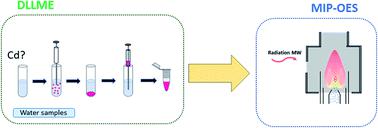当前位置:
X-MOL 学术
›
J. Anal. At. Spectrom.
›
论文详情
Our official English website, www.x-mol.net, welcomes your
feedback! (Note: you will need to create a separate account there.)
Evaluation of MIP-OES as a detector in DLLME procedures: application to Cd determination in water samples
Journal of Analytical Atomic Spectrometry ( IF 3.1 ) Pub Date : 2020-05-21 , DOI: 10.1039/d0ja00113a Raquel Serrano 1, 2, 3, 4, 5 , Guillermo Grindlay 1, 2, 3, 4, 5 , Przemysław Niedzielski 1, 6, 7, 8, 9 , Luis Gras 1, 2, 3, 4, 5 , Juan Mora 1, 2, 3, 4, 5
Journal of Analytical Atomic Spectrometry ( IF 3.1 ) Pub Date : 2020-05-21 , DOI: 10.1039/d0ja00113a Raquel Serrano 1, 2, 3, 4, 5 , Guillermo Grindlay 1, 2, 3, 4, 5 , Przemysław Niedzielski 1, 6, 7, 8, 9 , Luis Gras 1, 2, 3, 4, 5 , Juan Mora 1, 2, 3, 4, 5
Affiliation

|
High-power microwave induced plasma optical emission spectrometry (MIP-OES) constitutes a serious alternative to inductively coupled plasma optical emission spectrometry (ICP-OES) for elemental analysis. To improve the analytical capabilities of MIP-OES, dispersive liquid–liquid microextraction (DLLME) procedures seems to be, a priori, a very promising choice for trace and ultra-trace analysis in complex matrices. Nevertheless, to date, DLLME has never been coupled to MIP-OES. The goal of the present work is to investigate the capability of MIP-OES as a detector in DLLME procedures. To this end, spectral and non-spectral interferences caused by the presence of common DLLME extractants (i.e., chloroform and supramolecular solvent based on 1-decanol and THF) in MIP-OES have been evaluated. Results reveal the occurrence of both spectral and non-spectral interferences due to carbon-based molecular bands emission in MIP-OES. Carbon-based molecular emission (i.e. C2 and CH) significantly affects analyte wavelengths above 328 nm. By the appropriate selection of experimental conditions (i.e. analyte wavelength and nebulizer gas flow rate), both spectral and non-spectral interferences could be mitigated allowing elemental analysis by means of DLLME-MIP-OES. Different DLLME methodologies have been developed for Cd determination in water samples (i.e., tap, sparkling and synthetic seawater) by MIP-OES. These methodologies afford an enrichment factor of 46 and 42 for chloroform and supramolecular-based solvent DLLME procedures, respectively, and a limit of detection (LoD) of 1 μg L−1. This LoD is 100-fold lower than that obtained by conventional MIP-OES (i.e. no DLLME) due to both analyte preconcentration and the beneficial effect of organics on aerosol generation and transport. These analytical figures of merit are equivalent to those previously reported for DLLME-ICP-OES and allows Cd determination in water samples according to current international policies.
中文翻译:

DLLME程序中作为检测器的MIP-OES的评估:在水样品中Cd测定中的应用
大功率微波感应等离子体发射光谱(MIP-OES)构成了元素分析的电感耦合等离子体发射光谱(ICP-OES)的重要替代产品。为了提高MIP-OES的分析能力,似乎先验地将分散液-液微萃取(DLLME)程序用于复杂基质中痕量和超痕量分析的非常有希望的选择。但是,迄今为止,DLLME从未与MIP-OES耦合。本工作的目的是研究MIP-OES作为DLLME程序检测器的能力。为此,由于存在常见的DLLME萃取剂而引起的光谱和非光谱干扰(即,已评估了MIP-OES中的氯仿和基于1-癸醇和THF的超分子溶剂。结果表明,由于MIP-OES中基于碳的分子带发射,光谱和非光谱干扰均会发生。碳基分子发射(即C 2和CH)会显着影响328 nm以上的分析物波长。通过实验条件(适当的选择,即分析物的波长和雾化气流速),光谱和非光谱干扰可以减轻允许由DLLME-MIP-OES的手段元素分析。已经开发了不同的DLLME方法来测定水中的镉(即,水龙头,起泡和合成海水)。这些方法为氯仿和基于超分子的溶剂DLLME程序分别提供了46和42的富集因子,检测限(LoD)为1μgL -1。由于分析物预浓缩和有机物对气溶胶生成和运输的有益作用,该LoD值比常规MIP-OES(即没有DLLME)获得的LoD低100倍。这些品质因数与以前针对DLLME-ICP-OES所报告的一样,并且可以根据当前的国际政策确定水样中的Cd。
更新日期:2020-07-08
中文翻译:

DLLME程序中作为检测器的MIP-OES的评估:在水样品中Cd测定中的应用
大功率微波感应等离子体发射光谱(MIP-OES)构成了元素分析的电感耦合等离子体发射光谱(ICP-OES)的重要替代产品。为了提高MIP-OES的分析能力,似乎先验地将分散液-液微萃取(DLLME)程序用于复杂基质中痕量和超痕量分析的非常有希望的选择。但是,迄今为止,DLLME从未与MIP-OES耦合。本工作的目的是研究MIP-OES作为DLLME程序检测器的能力。为此,由于存在常见的DLLME萃取剂而引起的光谱和非光谱干扰(即,已评估了MIP-OES中的氯仿和基于1-癸醇和THF的超分子溶剂。结果表明,由于MIP-OES中基于碳的分子带发射,光谱和非光谱干扰均会发生。碳基分子发射(即C 2和CH)会显着影响328 nm以上的分析物波长。通过实验条件(适当的选择,即分析物的波长和雾化气流速),光谱和非光谱干扰可以减轻允许由DLLME-MIP-OES的手段元素分析。已经开发了不同的DLLME方法来测定水中的镉(即,水龙头,起泡和合成海水)。这些方法为氯仿和基于超分子的溶剂DLLME程序分别提供了46和42的富集因子,检测限(LoD)为1μgL -1。由于分析物预浓缩和有机物对气溶胶生成和运输的有益作用,该LoD值比常规MIP-OES(即没有DLLME)获得的LoD低100倍。这些品质因数与以前针对DLLME-ICP-OES所报告的一样,并且可以根据当前的国际政策确定水样中的Cd。











































 京公网安备 11010802027423号
京公网安备 11010802027423号